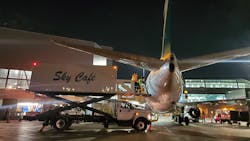Overcome Aircraft Catering Delivery Challenges through Precision and Proven Processes
The work of catering and commissary service is not without its challenges. In this article, Mike Hough, GAT chief executive officer of GAT, outlines some of those challenges.
Time is always a factor in airline servicing, but Hough says after many years of practice, airlines have built models to ensure enough time for all of the choreography that goes on around the aircraft.
“Each aircraft type, size, and planned routes have different times have all undergone independent time studies to ensure the servicing can be completed,” he says.
Food safety is an important consideration. Along the food’s entire journey, Hough says the process is tightly controlled.
“Temperatures, food quality, food handling and facility and transport cleanliness are non-negotiable and tested continuously. At the build facility, our dispatchers are monitoring the flight information closely and adjust kitchen departure times for delayed flights. If a flight gets delayed after the truck has been dispatched, the team monitors the length of delay in the event that we are in danger of passing a safety window. If that happens, a new truck is prepared and dispatched and the original truck is called to return to the facility,” he says.
Another challenge is security.
“There are very strict processes mandated and tested by federal agencies like the TSA to ensure nothing can be introduced through the catering system,” Hough says.
Lastly, there is little room for error because space on the aircraft is limited. The good news, according to Hough is there is a clear, trained choreography on how to load and unload the aircraft as well as a contingency plan if equipment is blocked out by something else.
About the Author
Rebecca Kanable
Assistant Editor
Rebecca Kanable, a veteran journalist, worked with Endeavor Business Media's aviation group from 2021 to 2024 as assistant editor of Airport Business, AMT and Ground Support Worldwide. She previously worked for various publications, including trade magazines and newspapers.

